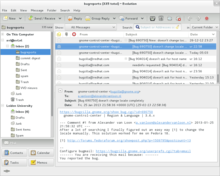
Back E-pos Afrikaans E-Mail ALS Correu electronico AN ईमेल ANP بريد إلكتروني Arabic برية إليكطرونية ARY ايميل ARZ ইমেইল Assamese Corréu electrónicu AST Elektron poçt Azerbaijani


Email (short for electronic mail; alternatively spelled e-mail) is a method of transmitting and receiving messages using electronic devices. It was conceived in the late–20th century as the digital version of, or counterpart to, mail (hence e- + mail). Email is a ubiquitous and very widely used communication medium; in current use, an email address is often treated as a basic and necessary part of many processes in business, commerce, government, education, entertainment, and other spheres of daily life in most countries.
Email operates across computer networks, primarily the Internet, and also local area networks. Today's email systems are based on a store-and-forward model. Email servers accept, forward, deliver, and store messages. Neither the users nor their computers are required to be online simultaneously; they need to connect, typically to a mail server or a webmail interface to send or receive messages or download it.
Originally a text-only ASCII communications medium, Internet email was extended by MIME to carry text in expanded character sets and multimedia content such as images. International email, with internationalized email addresses using UTF-8, is standardized but not widely adopted.[1]